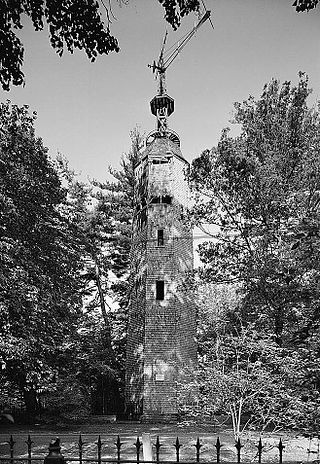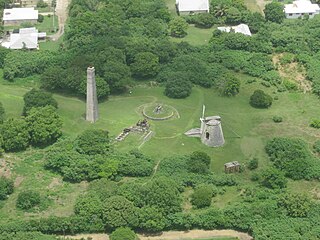Sion Hill, United States Virgin Islands | |
|---|---|
| Coordinates: 17°44′28″N64°44′50″W / 17.74111°N 64.74722°W | |
| Country | |
| Territory | |
| Time zone | UTC-4 (AST) |
Sion Hill is a settlement on the island of Saint Croix, in the United States Virgin Islands.
Sion Hill, United States Virgin Islands | |
|---|---|
| Coordinates: 17°44′28″N64°44′50″W / 17.74111°N 64.74722°W | |
| Country | |
| Territory | |
| Time zone | UTC-4 (AST) |
Sion Hill is a settlement on the island of Saint Croix, in the United States Virgin Islands.
The Sion Hill estate, a former sugarcane plantation, was the economic center of the area. The stone Danish colonial era plantation house, windmill base, and sugar processing factory buildings are now in ruins.
The windmill was used to power a sugar mill for crushing the sugar cane harvested on the plantation.
Sion Hill | |
 | |
| Nearest city | Christiansted, Virgin Islands |
|---|---|
| Area | 10 acres (4.0 ha) |
| Built | 1758 (mill) 1765 (house) |
| Architectural style | Classical Revival |
| NRHP reference No. | 76001850 [1] |
| Added to NRHP | July 19, 1976 |
The sugar plantation and rum distillery was established in the 18th century. The estate passed through several owners while it was in operation. The great house, the main residence on the plantation, is a one-story Classical Revival limestone building completed in 1765. The factory and grinding mill, the two primary buildings used for sugar production, were also made of limestone; the distillery is located within the factory building. The property also includes a cookhouse and a stable. [2]
The plantation was added to the National Register of Historic Places on July 19, 1976. [1]

The Pillsbury A-Mill is a former flour mill located on the east bank of the Mississippi River in Minneapolis, Minnesota. It was the world's largest flour mill for 40 years. Completed in 1881, it was owned by the Pillsbury Company and operated two of the most powerful direct-drive waterwheels ever built, each capable of generating 1,200 horsepower . In 1901 one of the turbines was replaced with a 2,500 horsepower one. Both the mill and its headrace tunnel are contributing resources to the St. Anthony Falls Historic District, which is listed on the National Register of Historic Places. The mill is also independently on the NRHP. The mill was named a National Historic Landmark in 1966 and has since been converted into the A-Mill Artist Lofts.

West Overton is a historic village located approximately 40 miles (64 km) southeast of Pittsburgh, in East Huntingdon Township, Westmoreland County, Pennsylvania, United States. It is on PA 819 between the towns of Mount Pleasant and Scottdale. Its latitude is 40.117N and its longitude is -79.564W. Known as the birthplace of industrialist and art collector Henry Clay Frick, it is also the original site of the distillery founded by his great-grandfather, Henry Overholt, and later operated by his grandfather, Abraham Overholt. This distillery is famous for producing Old Overholt rye whiskey.

Oatlands Historic House and Gardens is an estate located in Leesburg, Virginia, United States. Oatlands is operated by the National Trust for Historic Preservation and is listed on the National Register of Historic Places as a National Historic Landmark. The Oatlands property is composed of the main mansion and 415 acres of farmland and gardens. The house is judged one of the finest Federal period country estate houses in the nation.

The Windmill Hill Historic District is a historic district encompassing a large rural landscape in Jamestown, Rhode Island. It is bounded on the north by Eldred Avenue, on the east by East Shore Road, on the south by Great Creek, and on the west by Narragansett Bay. The area's historical resources included six farmsteads, as well as the Quaker Meetinghouse, the Jamestown Windmill, and its associated miller's house and barn. The area is predominantly rolling hills with open pastureland and forest. The district was listed on the National Register of Historic Places in 1978. The area is also rich in prehistoric evidence of Native American occupation, which is the subject of the Jamestown Archeological District listing on the National Register.

The Bronson Windmill is an historic windmill at 3015 Bronson Road in Fairfield, Connecticut. Built in 1893-94, it is the only surviving windmill in the town, ouf a number that once dotted the landscape. It was built for Frederic Bronson, owner of the local estate. The mill was listed on the National Register of Historic Places in 1971.

Cinnamon Bay Plantation is an approximately 300-acre (1.2 km2) property situated on the north central coast of Saint John in the United States Virgin Islands adjacent to Cinnamon Bay. The land, part of Virgin Islands National Park, was added to the United States National Register of Historic Places on July 11, 1978. Archaeological excavations of the land document ceremonial activity of the Taínos, as well as historic remains of plantation ruins.

Reef Bay Sugar Factory Historic District is a historic section of Saint John, United States Virgin Islands located on the south central coast adjacent to Reef Bay. The land is the site of a sugar factory. The property was added to the U.S. National Register of Historic Places on July 23, 1981.

Bethlehem Old Work is a settlement on the island of Saint Croix in the United States Virgin Islands. It was set-up as one of the first plantations in the 1730s, and operated as the last sugar plantation on the island until the Bethlehem Central Factory closed in 1966.
Clifton Hill is a settlement on the island of Saint Croix in the United States Virgin Islands.
Green Kay is a settlement on the island of Saint Croix in the United States Virgin Islands. It is located 3.3 miles (5.3 km) east of Christiansted.
Grove Place is a settlement on the island of Saint Croix in the United States Virgin Islands. It was added to the National Register of Historic Places in 1978.

Whim is a settlement on the island of Saint Croix in the United States Virgin Islands.
The Bethlehem Middle Works Historic District, in King's Quarter, in Southcentral, in Saint Croix, U.S. Virgin Islands, was listed on the National Register of Historic Places in 1988. It is also known as Estate Bethlehem Middle Works and as Bethlehem Middle Works. It is a 34 acres (14 ha) historic district which included 26 contributing buildings, two contributing structures, and four contributing sites.

Estate Judith's Fancy, subdistrict of Saint Croix, U.S. Virgin Islands, 4 miles (6.4 km) northwest of Christiansted is a former sugarcane plantation whose great house was built in 1733. Its surviving 3.6 acres (1.5 ha) property was listed on the National Register of Historic Places in 1978. The listing included six contributing sites.

The Estate Carolina Sugar Plantation near Coral Bay on Saint John, U.S. Virgin Islands is a historic sugar plantation and later rum distillery.

Whim is a historic sugar plantation located in Southwest subdistrict about 1.7 miles (2.7 km) southeast of Frederiksted on Centerline Road on Saint Croix, U.S. Virgin Islands. It was listed on the National Register of Historic Places in 1976. The listing included three contributing buildings, one contributing site, and two contributing structures, on 10 acres (4.0 ha).
Slob Historic District, near Christiansted, Virgin Islands, is a historic district which was listed on the National Register of Historic Places in 1987. The listing included nine contributing buildings, three contributing structures, and a contributing site on 9 acres (3.6 ha).
Estate St. John, near Christiansted on Saint Croix in the United States Virgin Islands, was listed on the National Register of Historic Places in 1978. It has also been known as St. Jan Plantage. The listing included two contributing buildings and a contributing structure.

Estate Butler's Bay, on the island of Saint Croix in the U.S. Virgin Islands, was established as a sugar plantation by 1764. It was listed on the National Register of Historic Places in 1978. The listing included five contributing buildings, a contributing structure, and five contributing sites.
Estate Mount Victory, near Frederiksted on Saint Croix in the U.S. Virgin Islands, is a sugar plantations listed on the National Register of Historic Places in 1978. The listing included five contributing sites on 7 acres (2.8 ha).